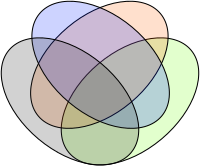
Photo from wikipedia
There are mainly two approaches to compare effects of two treatments: following the intersection–union principle (IU) or following the union–intersection principle (UI). The two approaches substantially differ by the role… Click to show full abstract
There are mainly two approaches to compare effects of two treatments: following the intersection–union principle (IU) or following the union–intersection principle (UI). The two approaches substantially differ by the role stated from the null and alternative hypotheses, which are mirror inverted. In particular, the IU principle considers as alternative hypothesis that the effect of a new treatment lies within a given interval around that of the comparative treatment, whereas the UI principle considers as alternative hypothesis that this effect lies outside that interval. Pesarin et al. recently discussed these two solutions and proposed a permutation approach based on the union-intersection framework.Often in pharmaceutical experiments it happens that more than one variable have to be simultaneously considered, in order to assess dissimilarity of two treatments. Generally this kind of problem is difficult to face outside the nonparametric framework, particularly due to the complex dependency structure among several variables and consequent related partial tests. Thus, the purpose of this article is to extend the existing UI-permutation solution toward a general multidimensional setting. In order to explain the performance and the applicability of the proposed method, a simulation study and application example are also shown.
Journal Title: Journal of Statistical Theory and Practice
Year Published: 2017
Link to full text (if available)
Share on Social Media: Sign Up to like & get
recommendations!